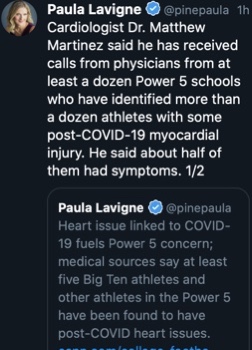In public relations, consistent communications help audiences remember you. Create a message that’s easy to recall; repeat the message, emphasize the message and weave that same message into the end of conversations so it’s the last thing people hear. It’s the same theory as marketing’s Rule of 7.
The problem with college, which is at the 11th-and-a-half hour to decide the fate of football in a COVID-19-dominated year, is that messages are all over the place. The only consistencies are inconsistency, disinformation and rumor. One athletic director says play, another says delay.
College sports’ decision makers had months to gather information and make decisions about whether teams should play a contact sport during a pandemic or not. Yet here we are when practices would typically be under way, and university presidents are hustling to decide whether college-age, amateur athletes should play in the shadows of or take the chance of becoming infected with COVID-19. As other leagues announced decisions not to play, messages from larger institutions said play-at-all-cost. That’s easyish when you have extra bucks in the bank and can afford to test athletes for the virus more than once each week. But when you look at the college sports landscape, beyond pretty buildings and lavish stadia are sports that have long been contested among haves and have nots. COVID, however, revealed crater-size cracks in the simple thrill of competition. Sans authority, everyone’s doing and saying their own thing.

As we sit here today, who could blame ADs and their bookkeepers whose programs stand to lose millions of dollars if games aren’t contested and televised? Along with several coaches and athletes, they’re saying, #letusplay. University presidents aren’t so sure. Liability suits are expensive, too.

The social media machine, as you’d expect, is pointing fingers in every direction with blame if ball isn’t played. Let’s start at the top, though. We’re in the midst of a pandemic that has killed more than 160,000 people in the United States alone. The person tasked with educating, informing and assuring Americans with the most accurate information to thwart the novel coronavirus (the President of the United States) has continually denied its severity and blamed others for mass outbreaks and lack of testing. On the occasions that he brought epidemiologists to the table, he criticized the science. That mixed messaging trickled down into sports and our communities. Young, otherwise healthy people can’t get the novel coronavirus, he said. Wrong. Athletes are tough and won’t suffer if they get COVID. Unfortunately we’ve learned otherwise.
So here we are, after more than five months for leaders to make contingency plans and the NCAA, university presidents and other college leaders are sprinting to patchwork solutions. Fans are hopeful, frustrated and making up their own takes, which is what happens when people in charge don’t set a narrative and communicate frequently and consistently.
There are changes coming to college athletics sooner than later, and college athletes are using their voices in ways and numbers they never have, so it behooves sports organizations to use this communications conundrum as a lesson. Designate a voice, agree on a message and own it. Say that changes may be required, and you’ll communicate if and when that happens. The process won’t solve everything, but instead of discombobulated, sports will come off prepared, not scared.
©Gail Sideman; gpublicity.com 2020
###